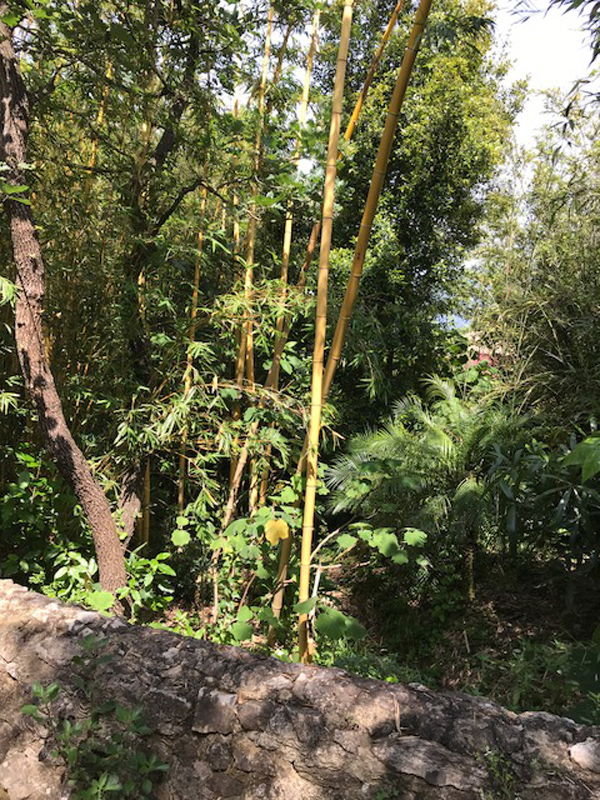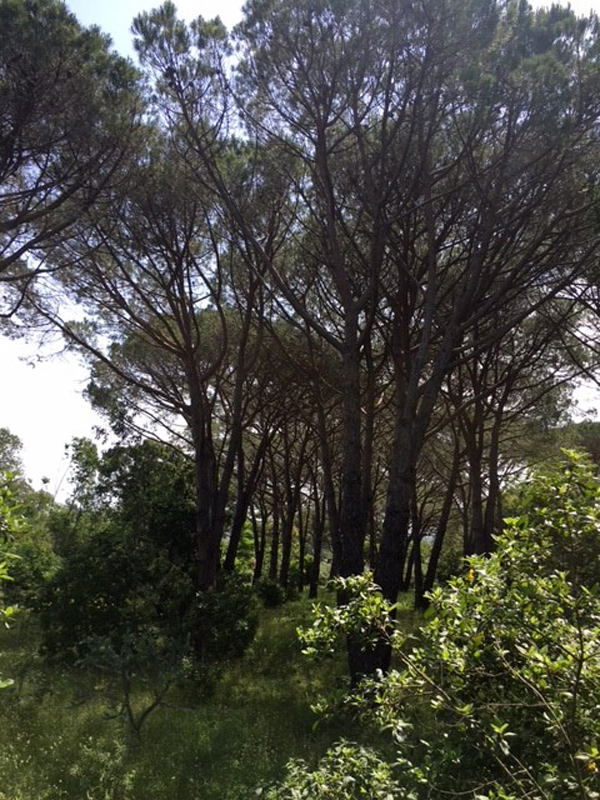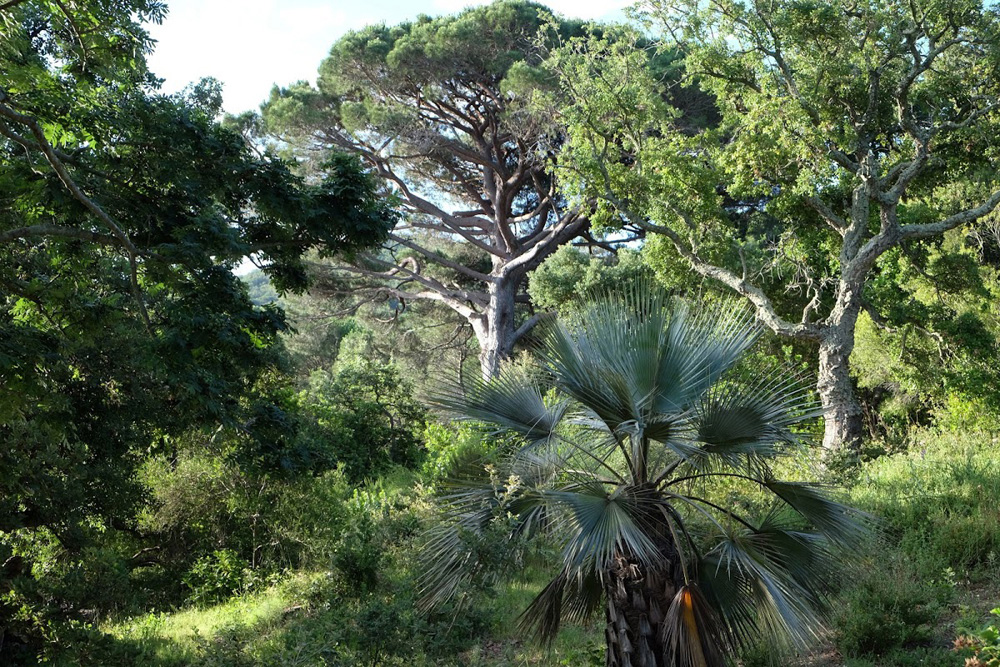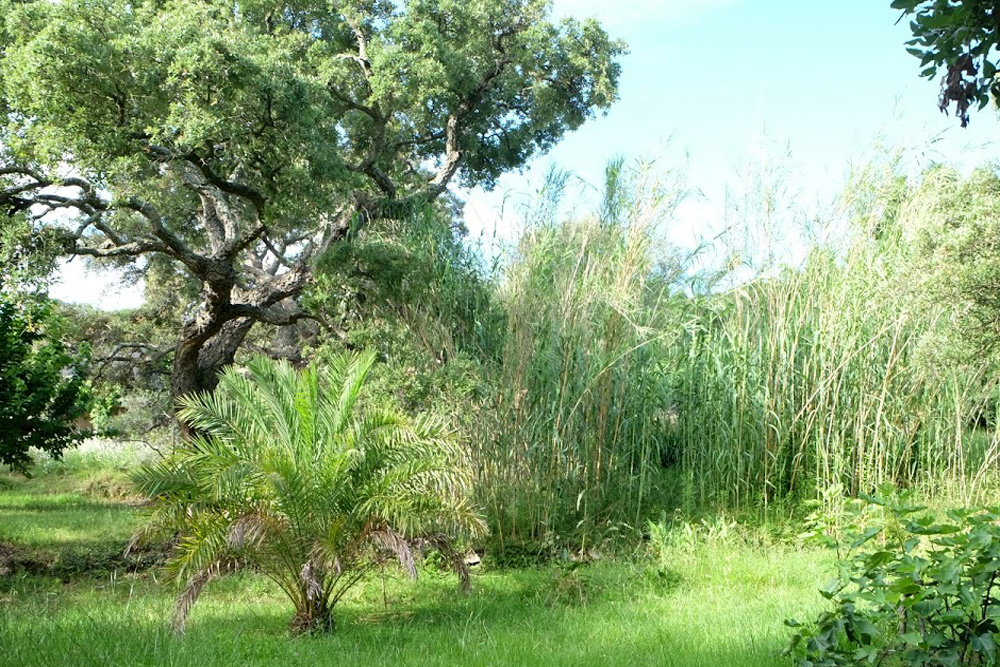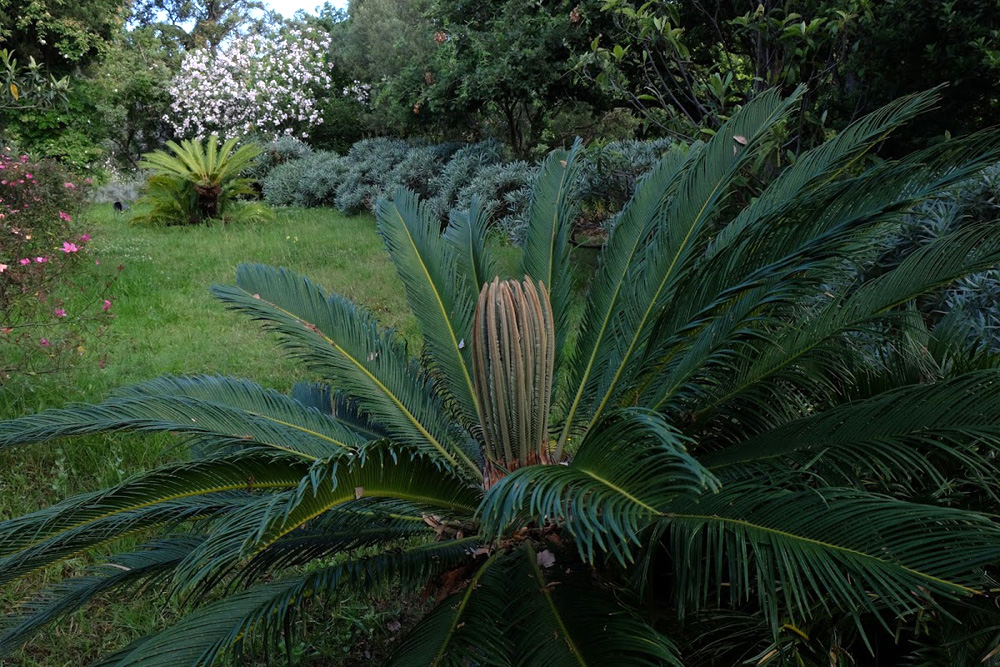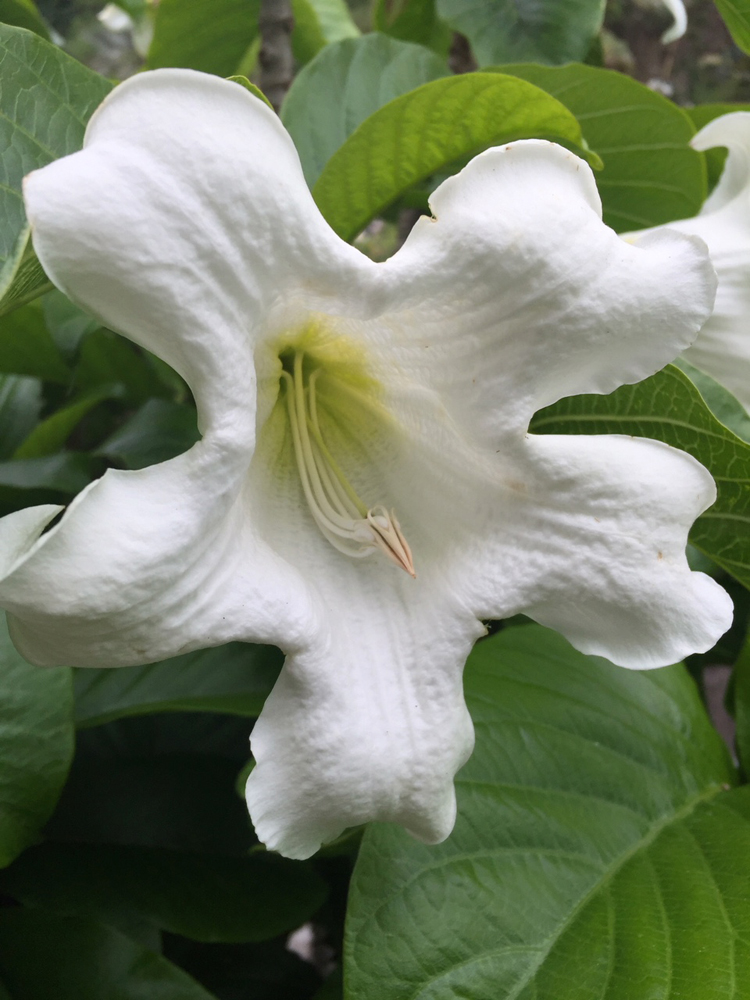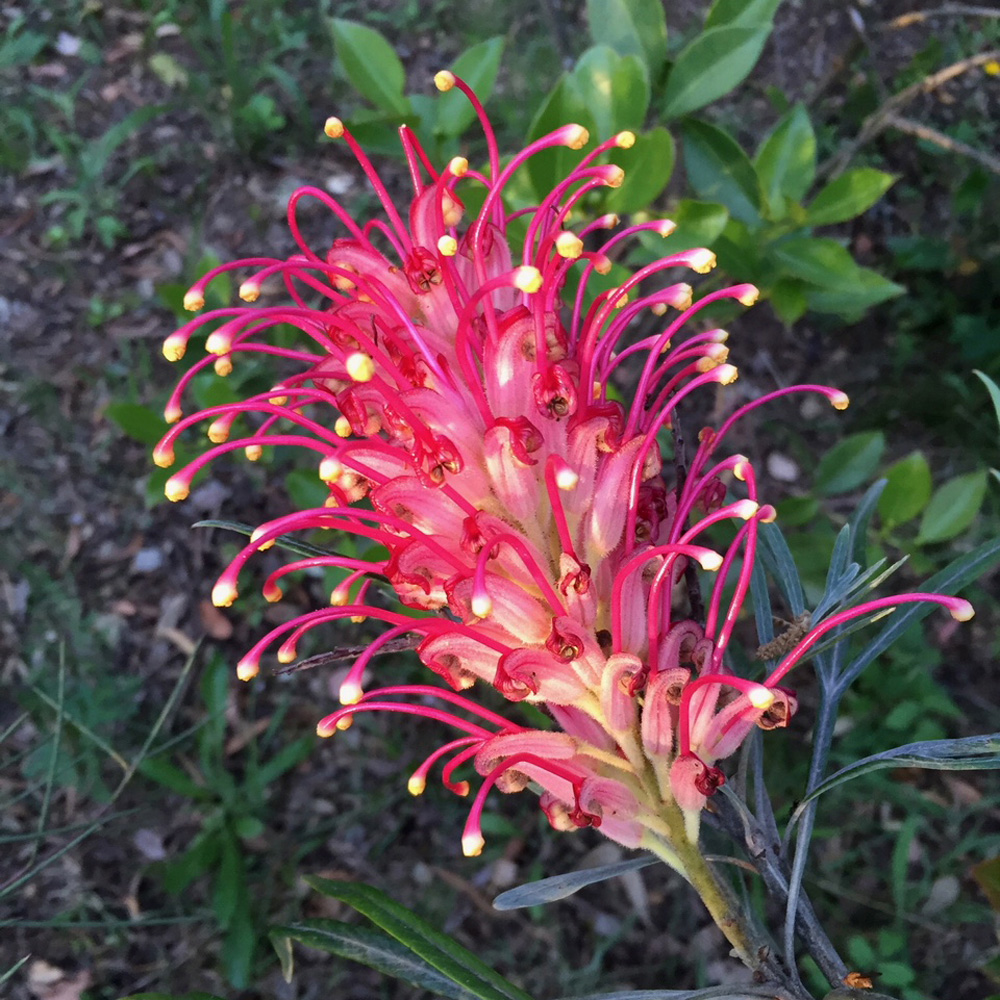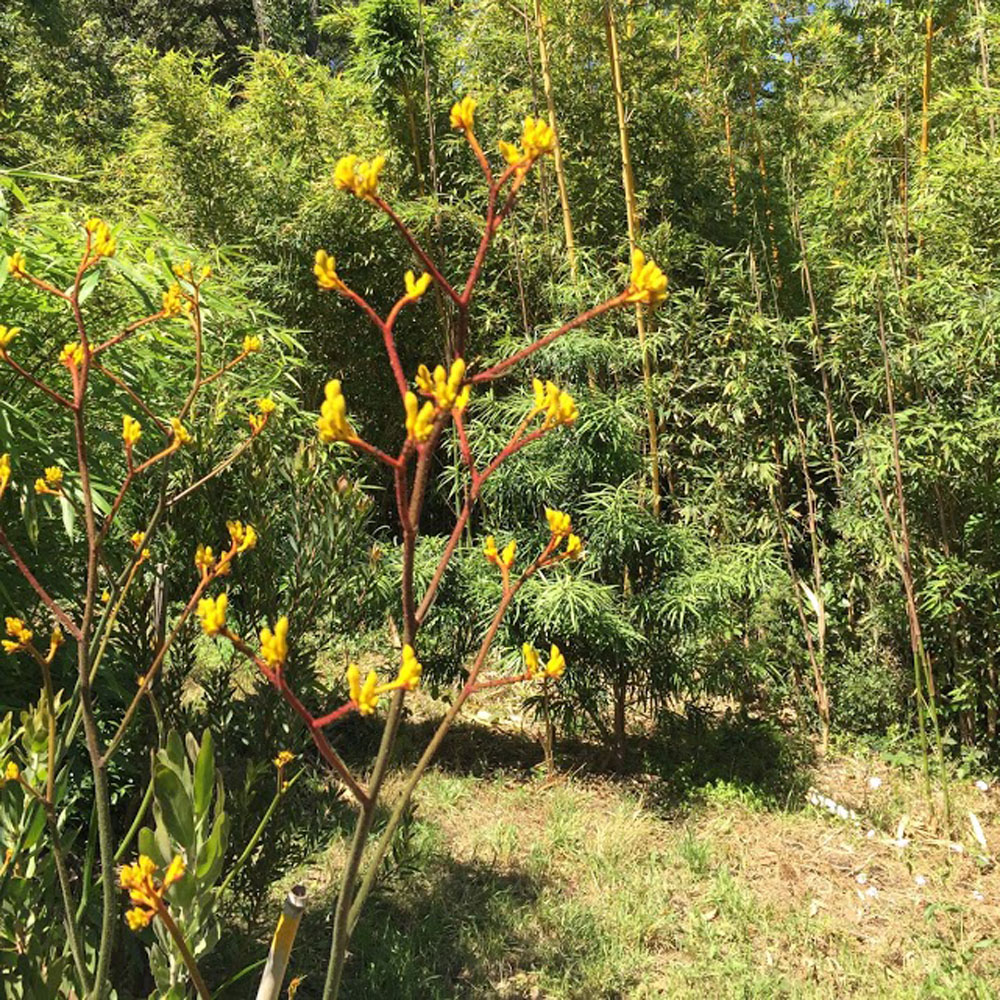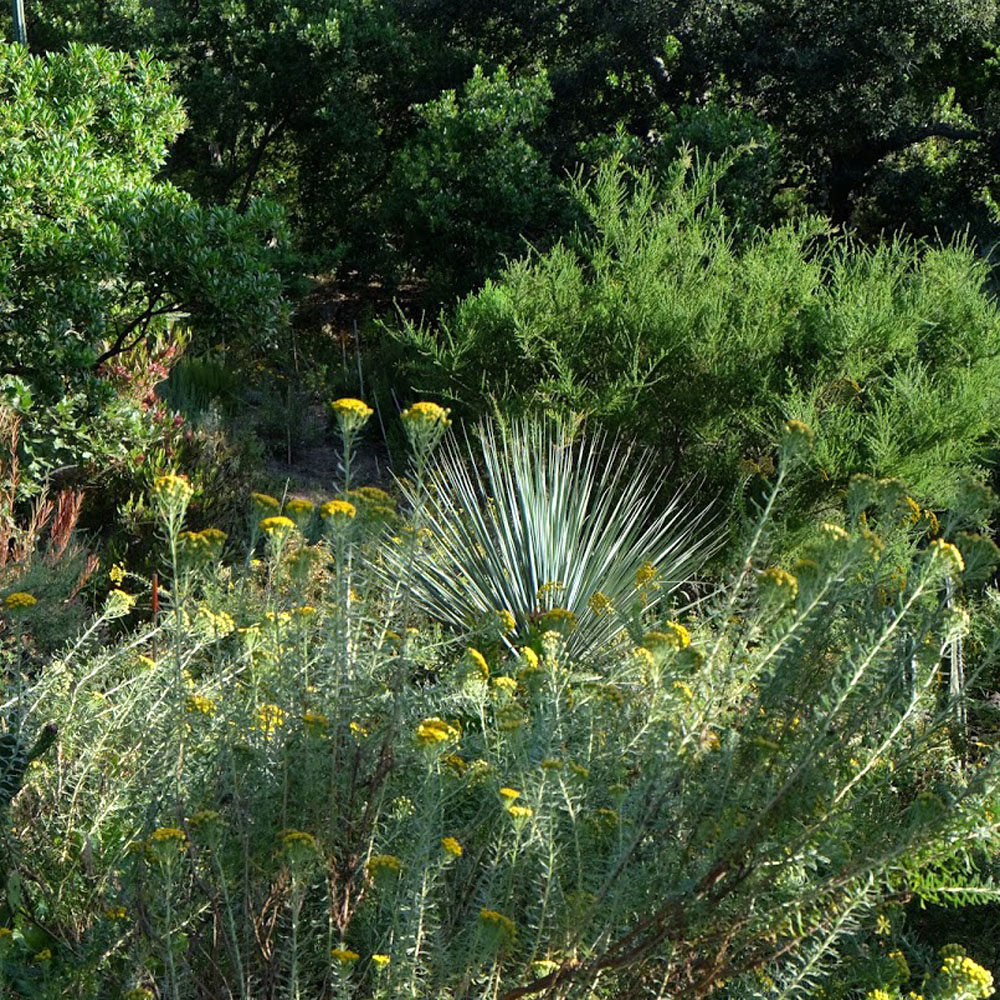May / mai 2018
A visit to a garden overlooking the bay of Saint-Tropez, Var
Click on an image to enlarge it / Cliquez sur une image pour l’agrandir
Not far from the bustle of Saint-Tropez lies the little oasis of tranquillity that is this six hectare garden. We had the honour of being hosted there by the owners, who bought the property in 2002. While it had originally been a farmhouse with a vineyard, the vines had been removed post World War II and the property had reverted to its natural state.
We started our visit on the vine-covered veranda where our host told us the story of the garden and their concept of creating as natural a setting as possible. Then he guided us round the extensive gardens where he was able to talk in great detail about the many and varied plants, shrubs and trees from all over the world. It was a fascinating tour de force.
As we set out up the hill behind the house, he showed us a small area that had been cleared before planting, adjacent to another area where plants had been introduced amongst the natural flora. The difference between the two areas was striking with the complete ground cover from the native species providing a much healthier habitat. Going further up, the garden was drier and the plants reflected that.
The plants are too extensive to talk about individually. The cacti were lovely, very varied and healthy and we were surprised to hear that although they don’t relish a wet, cold winter like the last one, they do require watering in the warm weather to mimic their natural habitat.
Like so many gardens in Provence, the challenge has been to keep the wild boar out, and keeping it pig free has enabled plants such as wild orchids to grow and flourish. Narrow paths wind through the garden giving a very natural feel to the property, yet the planting ranges from cacti and succulents through a vast array of acacias, to wonderfully scented roses and stands of bamboo. Most striking of the roses was the yellow-flowered Rosa ‘Golden Wings’. The owner explained to us how he controlled and pruned the bamboos using know-how gleaned from Japan.
Amongst the mature trees found throughout the garden were indigenous cork oaks and deciduous northern oaks living happily side by side in this sheltered north-facing habitat. The umbrella pines looked superb, due to the practice of ‘tree cleaning’ where teams of climbers periodically remove all dead branches, twigs and old needles from the trees.
In the lower parts of the garden, where plants were being watered, there were unusual plants from all over the world including a climbing ruscus and many varieties of camellia that flower in the autumn – unlike their British counterparts. Some of the old vineyard terraces had been planted with roses and a vegetable garden.
The visit concluded with a picnic lunch on the terrace where our generous hosts provided us with everything we could ask for including delicious local wine and coffee.
Our grateful thanks to the owners for their generous hospitality and the chance to share the paradise that they have created.
Text and photos: John and Jill Patterson
An illustrated account of the garden, by its owners
The garden was laid out on land which used to be a vineyard, which we acquired in July 2002. It is located at an altitude of about 50 m on a hill facing North-North-East over the bay of Saint-Tropez (latitude 43°). This gives it a slightly cooler climate in summer and slightly warmer in winter because the bay tempers the cold coming down from the Alps to the north. However, the mistral blows straight in and the east wind skirts it. The soli is neutral tending towards acid, this fact confirmed by the presence of cork oaks and umbrella pines.
Le jardin a été conçu au sein d’une ancienne propriété viticole que nous avons acquise en juillet 2002. Il se trouve à une altitude d’environ 50 m sur une colline orientée Nord-Nord-Est au-dessus de la baie de Saint-Tropez (latitude 43°). Ceci lui donne un climat un peu moins chaud l’été et un peu moins froid l’hiver car l’eau de la baie adoucit le froid qui descend des Alpes toutes proches. Cependant le mistral lui vient droit dessus et le vent d’est l’effleure. La terre est neutre tendant vers l’acide ce qui est attesté par des chênes liège et des pins parasols.
We inherited ancient terraces, raised paths, deep ditches for the evacuation of rainwater and the beautiful endemic vegetation of the ‘forêt tropézienne’ consisting of Quercus suber, Quercus pubescens, Arbutus unedo, Laurus nobilis, Viburnum tinus, Phillyrea angustifolia, Myrtus communis, Pistacia lentiscus, Erica arborea, (whose roots are used for making pipes in Cogolin), various cistus, including Cistus salviifolius, C. ladanifer and C. monspeliensis and a quantity of wild flowers, including nine species of orchids.
Nous avons eu la chance d’hériter de restanques et de chemins surélevés, bordés de profonds fossés pour évacuer les eaux de pluies et partout d’une belle végétation endémique de la forêt tropézienne. Quercus suber, Quercus pubescens, Arbutus unedo, Laurus nobilis, Viburnum tinus, Phillyrea angustifolia, Myrtus communis, Pistacia lentiscus, Erica arborea (dont les racines servent à faire des pipes à Cogolin), une variété de cistes, y compris Cistus salviifolius, C. ladanifer et C. monspeliensis et une quantité de fleurs sauvages, dont neuf espèces d’orchidées répertoriées.
The parasol pines, Pinus pinea could be said to be endemic, since they were imported by the Romans over two thousand years ago, but they continue to behave as invaders.
Des Pinus pinea on pourrait dire qu’ils sont endémiques, puisqu’ils ont été importés par les Romains il y a plus de deux mille ans, mais ils continuent à se comporter comme des envahisseurs.
Into this endemic vegetation we have introduced plants from other Mediterranean climate zones (climates whose dryness in summer forces plants to be dormant). These include South Africa, Australia, California, Chile and other dry and desert climates (above the house) and plants from warm climates but which need some watering (below the house).
Parmi cette grande richesse végétale nous avons mis des plantes d’autres climats dits méditerranéens (climats dont la sécheresse l’été force les plantes à se mettre en dormance). Ceux d’Afrique du Sud, d’Australie, de Californie, du Chili et d’autres climats secs et désertiques (au-dessus de la maison) et des plantes de climats chauds mais aimant un peu d’eau (en-dessous de la maison).
Walking towards the house there is a meadow to the right with the giant reed Arundo donax surrounding Iris pseudacorus and Hedychium coronarium and below, a Phoenix sylvestris, a palm that can be seen in the Rajasthan countryside. Further away at the foot of a large cork oak is a Phoenix theophrastii, a palm endemic to Crete. Near to the house, is a collection of arbutus dominated by a pubescent oak with low branches above a garden of roses, jasmine and hydrangeas. Higher up is a terrace lined with cork oaks and cypresses under which grow echium, a large ceanothus and two large Cycas revoluta. A garden of Rosa mutabilis and gaura leads to the kitchen garden.
En montant le chemin vers la maison il y a à droite une prairie bordée de Arundo donax qui entourent des Iris pseudacorus et des Hedychium coronarium et en dessous un Phoenix sylvestris, un palmier que l’on voit dans la campagne du Rajasthan. Plus loin au pied d’un gros chêne liège, un Phoenix théophrastii, palmier endémique de Crète. Vers la maison il y a une collection d’arbousiers dominée par un chêne aux branches basses et un jardin de rosiers, de jasmins et d’hydrangeas. Plus haut, il y a une terrasse bordée de chênes liège et de cyprès sous lesquels poussent des echium, un grand céanothe et deux gros Cycas revoluta. Un jardin de Rosa chinensis et gaura mène au potager.
To the north of the house are a large brugmansia, Calliandra portoricense, and Senecio fulgens. To the south, Beaumontia grandiflora, Eryobotria deflexa, and Lonicera hildebrandiana; at the top of the steps, Salvia azurea, Romneya coulteri, and Melaleuca elliptica (wine-red bottle brush flowers) and to the south of a ‘bassin’ Erythrina crista-galli, Nerium oleander and Podranea ricasoliana.
Autour de la maison, au nord, un brugmansia, des Calliandra portoricense, et un Senecio fulgens. Au sud un Beaumontia grandiflora, un Eryobotria deflexa, et un Lonicera hildebrandiana ; au sommet des marches, Salvia azurea, Romneya coulteri, et Melaleuca elliptica (fleurs rouge lie de vin) et au sud du bassin lavoir une Erythrina crista-galli, des Nerium oleander et une Podranea ricasoliana.
Around the barn are blue-foliaged Acacia covenyi and a Dombeya burgessiae with Pelargonium sidoides and P. iodatum, a large fig tree, Brachychiton acerifolius, Salvia involucrata ‘Hot Lips’, S. cacaliifolia and S. guaranitica. At the foot of a hill covered in parasol pines, there is a Mediterranean dry garden inspired by the cliff-edged plateaus overlooking the ocean on the west coast of the Algarve, in Portugal. New plantings are watered every few weeks for their first few years, then spend the summer without water, semi-dormant, and re-awaken for the autumn, winter and spring.
Autour de la grange, Acacia covenyi au feuillage bleuté et un Dombeya burgessiae, des Pelargonium sidoides et P.iodatum, un grand figuier, Brachychiton acerifolius, Salvia involucrata ‘Hot Lips’, S. cacaliifolia et S. guaranitica. Au pied de la colline des pins, vous verrez un jardin sec méditerranéen inspiré par les plateaux qui dominent l’océan sur la côte ouest de l’Algarve portugais. Après quelques années d’un arrosage espacé de quelques semaines, ces plantes passent l’été sans arrosage, et se réveillent en automne, en hiver et au printemps.
Up in the hill among the pines, there are cacti, agaves, yuccas, puyas, aloes, acacias, Dasylirion wheeleri, Nolina nelsonii and some plants which prefer dry conditions: Cleistocactus strausii and C. jujuyensis, orocereus, espostoa, echinopsis, cephalocereus and pachycereus.
Au-delà parmi les pins, il y a des cactus, des agaves, des yuccas, des puyas, des aloës, des acacias, des Dasylirion wheeleri, un Nolina nelsonii et quelques plantes qui aiment le sec : Cleistocactus strausii et C. jujuyensis, orocereus, espostoa, echinopsis, cephalocereus et pachycereus.
Coming down the hill are Australian plants: grevillea, melaleuca, acacias, banksia, Xanthorrhoea arborea, anigozanthos and ozothamnus, and South African plants: proteas, leucadendrons, restios, Athanasia crithmifolia and Chondropetalum tectorum.
En descendant de la colline des plantes australiennes : grevillea, melaleuca, des acacias, des banksia, des Xanthorrhoea arborea, anigozanthos et ozothamnus ; et des plantes sud-africaines : protea, leucadendron, des restios, Athanasia crithmifolia et Chondropetalum tectorum.
A path leads to some palm trees: two Trachycarpus wagnerianus, a large Chinese palm tree (Livistona sinensis), Syagrus romanzoffiana and a Chamaerops humilis ‘Vulcano’ (from the Aeolian island of Vulcano). Further on is a Butia capitata with glaucous blue leaves and in the undergrowth, Chamaedorea microspadix and Livistona decipiens.
Un sentier mène vers quelques palmiers : deux Trachycarpus wagnerianus, un grand palmier de Chine (Livistona sinensis), Syagrus romanzoffiana et un Chamaerops humilis ‘ Vulcano’ (de l’île Eolienne de Vulcano). Au fond, un Butia capitata aux palmes bleu glauque et dans le sous-bois, des Chamaedorea microspadix et des Livistona decipiens.
Below, bamboos, eucalyptus, Hymenosporum flavum, Lyonothamnus floribundus, several acacia, hakea, casuarina, grevillea, Banksia robur, solanum, dianella, leucadendron, calliandra, Sparmannia africana and some palms, Arenga engleri, Livistona australis and Chamaedora radicalis. Bamboos include a large yellow variety streaked with green (Phylostachys aureosulcata ‘Aureocaulis’), black bamboo (Phylostachys nigra), a yellow one streaked with finer green lines (Bambusa ‘Alphonse Karr’) and some very fine bamboos in large clumps, one with short leaves, Himalayacalamus sp. and one with long leaves, from Mexico, Otatea acuminata ssp. aztecorum.
Plus bas, des bambous, des eucalyptus, un Hymenosporum flavum, un Lyonothamnus floribundus, plusieurs acacia, hakea, casuarina, grevillea, Banksia robur, solanum, dianella, leucadendron, calliandra, Sparmannia africana, et quelques palmiers Arenga engleri, Livistona australis et Chamaedora radicalis. Les gros bambous jaunes striés de vert (Phyllostachys aureosulcata ‘Aureocaulis’), les bambous noirs (P. nigra), les jaunes striés de lignes vertes plus fines (Bambusa ‘Alphonse Karr’) et les bambous très fins en grandes touffes à courtes feuille, Himalayacalamus sp. et, à longues feuilles, Otatea acuminata ssp. aztecorum du Mexique.
South of the bamboos is a small grove where we unsuccessfully tried the tree fern, Dicksonia antarctica and found that other ferns, Pteris multifida and Polystichum setiferum, adapt better. We added cussonias, dianella, aspidistra, ligularia, cordylines and a Semele androgyna.
Au sud des bambous, un petit vallon où nous avons essayé sans succès des fougères arborescentes, Dicksonia antarctica, d’autres fougères, Pteris multifida et Polystichum setiferum, s’adaptent mieux,. Nous y avons ajouté des cussonias, des dianella, des aspidistras, des ligularias, des cordylines et un Semele androgyna.
Leaving the bamboo, an elevated path takes one to the olive trees, a small cork oak wood and to the remains of an old threshing floor surrounded by box. Beyond are Camellia sasanqua, osmanthus, michelia and some Japanese maples; but the combination of wind, pine tree roots and the dry summer climate are inimical to maintaining the moisture that these plants need.
En quittant les bambous, un chemin surélevé vous amène aux oliviers et à un petit bois de chêne-liège au sud duquel une ancienne aire de battage est entourée de buis. Au-delà vers l’est, nous essayons des Camellia sasanqua, des osmanthus, des michelia et quelques érables japonais ; mais le vent, les racines des pins et le climat sec de l’été ne permettent pas à l’arrosage de maintenir l’humidité dont ces plantes ont besoin.
![]()


